


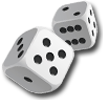
play board games
Board game reviews, strategy tips & session reports
Halo Fleet Battles Review
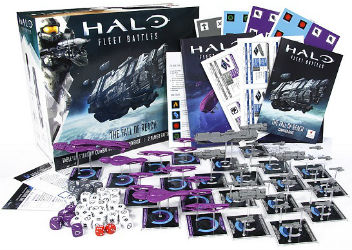 Stats:
Stats:
No. of players: 2
Amount of time to play: 60-120 min (depending on the scenario)
Age requirements: 12+
Set-up time: 5 – 10 min (if your Battle Groups are prepared)
Halo: Fleet Battles – The Fall of Reach has everything you need to start playing this capital ship combat miniatures game.
Halo Fleet Battles Rules Description:
The Fall of Reach is a 2 player battle box for Halo Fleet Battles. It has 49 plastic miniature ships, terrain for battlefields and a scenario book. The miniatures need to be assembled, but not necessarily painted. The 32 UNSC ships are gray and the 17 Covenant ships are purple.
The provided scenarios give you ready to play fleets. But you can also build your own. The specific ships and their formation on their base determine their stats. So the same ships might have different dice pools and damage tracks depending on their formation.
Each turn you roll your five command dice. These custom dice let you issue orders to your fleet. To issue an order you must have dice that match the icons needed for the order you wish to use. Each commander has different orders and the more powerful the order the more dice you need to match its icons. Some let you re-roll attack dice and others let you defend better against specific attacks.
You roll a d6 for initiative and the player that rolls the highest gets to choose who goes first. Then the first player activates their first wing. Wings are groups of small fighters and bombers that come with some ships. Players alternate activating wings until all have moved. Then if they are in range of a target they alternate attacking.
The same alternating play occurs in the Battle Group Phase. But this time you move and attack with each Battle Group. Battle Groups are made up of smaller groups of ships. Movement is in inches and you may turn in different ways depending on the size of the ship. Small ships may turn up to 45 degrees before and after they move. Medium sized ships may turn up to 45 degrees either before or after they move. And large ships may only turn up to 45 degrees after they move. After moving all ships in one Battle Group must be within six inches of another.
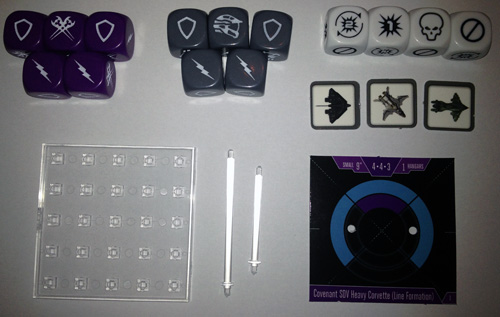
Attacks are resolved with custom dice. They have three sides that miss one that counts as one success and another that counts as two successes. But before you fire you need to be sure of a few things. First is your target must be in the firing arc of the weapon you are using. Then you measure to see if it is a short or long range attack and if you are you firing through terrain. Based on your weapon and the answer to these questions you find you firepower rating. The better your firepower rating, you are able to re-roll the more dice that miss. You add up all your successes and your opponent rolls their defense dice adding up their successes. Each success the defender rolls removes one success from the attacker’s pool. Any remaining successes are compared to the damage track of the defending ship. If they meet or beat the damage rating, they get one damage token. If a ship has damage tokens equal to the number of damage ratings it has, it is destroyed.
The last action-packed part of the round is the Boarding Phase. This is when players launch boarding parties at other ships to destroy them from the inside. Board parties may be fired in a 360 degree arc at a distance equal to its ship’s movement. And their success at boarding is resolved similarly to the above. The difference is both player roll a d6 to find the results of the boarding action. The higher the attacker rolls the more devastating the attack.
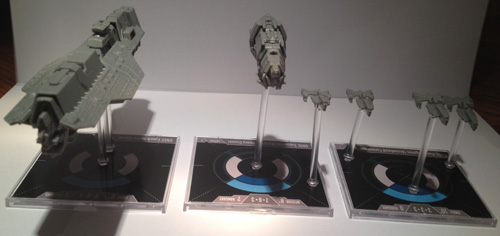
You keep battling back and forth until one player reaches the victory conditions of the scenario or you have played the numbers of rounds called for in the scenario.
Quick Review of Halo Fleet Battles:
Halo Fleet Battles – The Fall of Reach has everything you need to play the game. And though the rulebook seems large the game system is intuitive and moves quickly. It will take a few games for things to run smooth, but the introductory scenarios slowly add elements to help you learn the system.
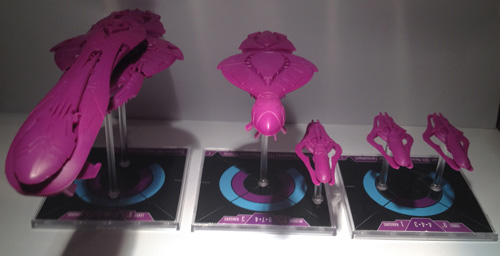
The components for this game are great. The miniatures need to be assembled but they fit easily together and it shouldn’t take you too long. And since the miniatures are colored plastic, you don’t need to paint them. The rules are well written and full of examples. The index in the rulebook is thorough and invaluable the first few games. The terrain looks cool. And the player aid is very helpful (though it would be nice to get two). The wing tokens look good but keeping track of the number in a stack can be tricky.
I like how easy movement is in this system. Turn and move or vice versa (or both). It is that easy. You also measure before you move or fire which I always like.
You might not agree but I think rolling a bunch of dice is great. And you have the chance to do just that in this game. Figuring out damage from both the attacker’s and defender’s dice results is intuitive and quick.
The bases allowing for different overlays and multiple formations are innovative. This system makes building fleets quick and adaptable. This will get even better as more ships are added to the system with expansions.
There are a couple of minor things I wish were different. The game comes with one commander for thee both sides. Another commander per side would be nice and create a bit more variety for both players.
Halo Fleet Battles is 100% for you if you like tabletop miniature games and Halo. If you are just a fan of one or the other it might depend. For Halo fans that aren’t tabletop miniatures gamers, there will be a learning curve. But once you grasp this system it is a lot of fun. For tabletop miniatures gamers that are ambivalent to the Halo universe, this is a well-designed system with expansions that should only make it better.
Score and synopsis: (Click here for an explanation of these review categories.)
Strategy 4 out of 6
Luck 4 out of 6
Player Interaction 6 out of 6
Replay Value 5 out of 6
Complexity 4 out of 6
Fun 5 out of 6
Overall 5 out of 6

Leave a Reply